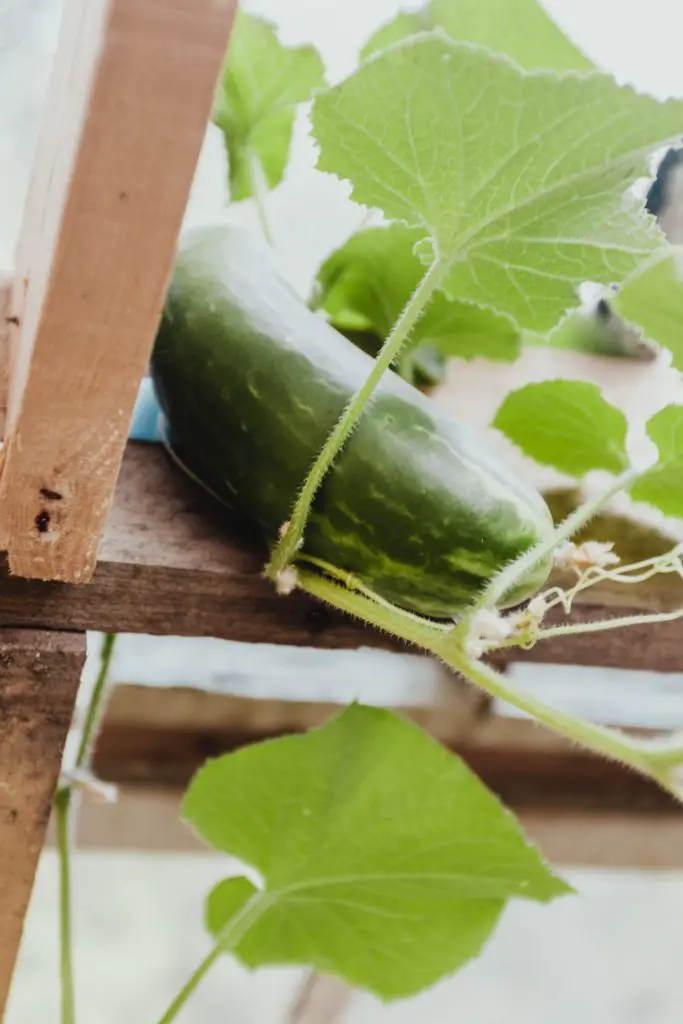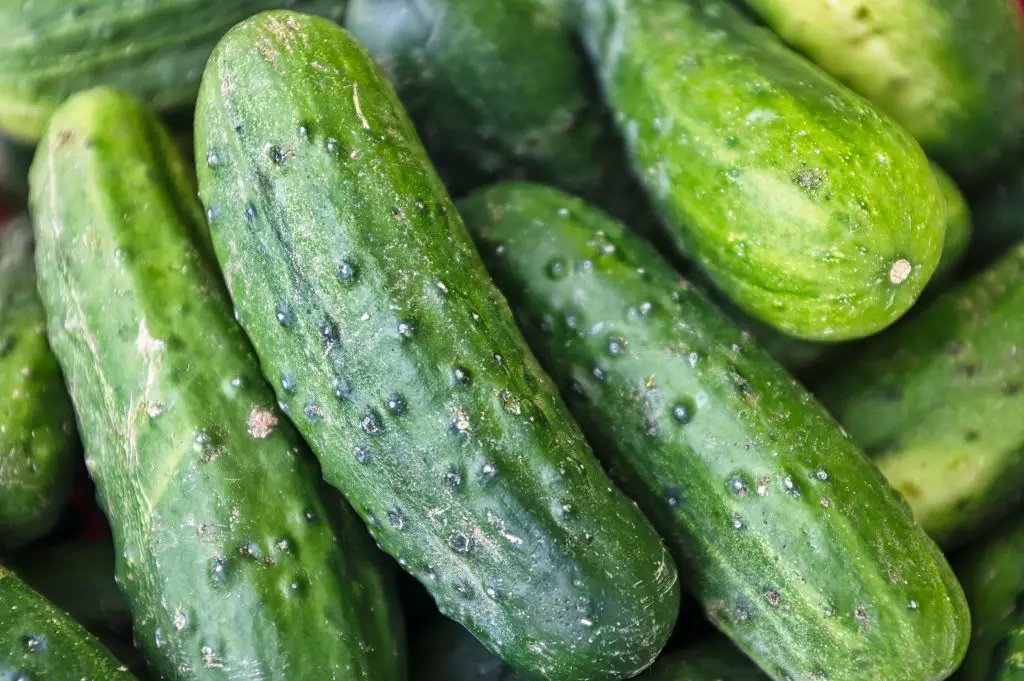What Makes Cucumber Turn Yellow? Cucumbers are a popular summer crop that is grown widely around the world. They grow on a sprawling vine that can become extremely prolific in warm conditions. Most varieties produce a cylindrical-shaped fruit that is green in color. But there is some fruit that have turned yellow. So is there a problem? Is the fruit still edible?
Cucumber can turn yellow for several reasons, but the most common reason, by far, is that the fruit has become overripe and is beginning to decay. The other possibles cause is a lack of water, a boron deficiency, or the presence of diseases such as Anthracnose and Belly rot which are both fungal diseases that cause discoloration of the fruits.
Generally, disease and nutrient issues are associated with an uneven coloration across the fruits whereas overripe fruit tends to be more uniform in color. Overripe fruit is most commonly left on the vine in late summer when there is a glut of fruit and supply is outstripping demand.
To manage the glut of cucumbers in a home garden and get the very best out of your cucumbers it is important to not wait until the fruit gets to “traditional” supermarket size. Pick them as you need them and don’t worry if they are relatively small. Cucumbers can be picked at any stage, however, I generally recommend picking the cucumbers when they are a bit larger than a dill pickle.

How To Prevent Water Deficiency
Aside from becoming overripe the other common reason for the yellowing of fruit is the inconsistent availability of water. This tends to occur more frequently if cucumbers are grown in pots, containers or grow bags. Apart from stating the obvious and saying water more regularly, there are a couple of things that you can do to reduce water stress.
The first is to increase the water-holding capacity of the soil that the plant is growing in. This can be achieved by adding additional compost to the soil, however, if the soil is already quite hydrophobic (repels water) it may worth also adding a wetting agent.
Wetting agents are available in liquid and granular forms. I prefer to use the granulated forms as they usually last for a longer period. However, even with this type, you will need to apply it every 6 weeks or so if the soil is really problematic.
The water holding capacity can also be improved by adding hydrogels (sometimes called water crystals) to the soil. The hydrogels are specially designed polymers that absorb water and release it over time. The research we conducted indicates that the addition of hydrogels increases the moisture within the soil and extends the period that plants can survive without watering. To read more about it click here.
When adding the hydrogels to the soil it is best to hydrate them in a bucket first and then mix it into the soil. The reason for this is that the hydrogels swell dramatically in size, and it is easy to overestimate the amount required when it is added as a powder directly to the soil.

The second thing that can be done is to ensure that the ground is adequately covered with a thick layer of mulch to help retain any water that the soil receives and also suppress weeds which can compete for water and nutrients.
In terms of ensuring that there are adequate nutrients in the soil there are a few simple things that can be done that will avoid 95% of problems. The first is to mulch with compost rather than straw or wood chips once a year. This habit will ensure that the soil health will improve year on year.
To see an excellent example of the effectiveness of this approach have a look at Charles Dowdings’ website or youtube channel. He demonstrates how this approach alone is sufficient to supply all the nutrients you will ever need.
The other important consideration to look at if you are having problems is the soils’ pH which can affect the availability of nutrients to the plants. The ideal pH for most plants is 6 to 7 and it can easily be measured using a pH meter from Amazon, click here to see the latest price.
What Are The Symptoms Of Boron Deficiency And How To Fix It
There are many possible nutrient deficiencies that can affect the growth of the cucumber plant however, the majority of these issues present themselves as symptoms in the leaves. A detailed list of possible problems associated with cucumbers and their symptoms may be found on the NSW Department of Primary Industries website.
However, one nutrient deficiency that does present itself as a yellowing of fruit is a boron deficiency. The signs on mature fruit are distinctive and include mottled yellow longitudinal streaks. These symptoms are most apparent at the blossom end of the fruit.
Boron deficiency also appears in the leaves, though the nature of the symptoms is different in older leaves versus newer leaves. New leaves can become distorted in shape and in some cases even dry back completely, whereas in older leaves a broad yellow border is formed on the edges of the leaves. Additionally, it is common to see young fruit dying off at high rates.

These issues can be corrected by applying a borax spray to the leaves. The spray can be prepared by dissolving 1 teaspoon of borax in a quart (1 litre) of hot water. The spray should be applied to the leaves, however, it is important to note that the boron can also become quite toxic to the plant at relatively low levels.
As such it is advisable to select only one plant to spray initially and then leave it for a week to see if there is any improvement before spraying other plants.
Are Yellow Cucumbers Useful For Anything?
Overripe Yellow cucumbers are still useful to some degree. You can chance your arm and try to eat them raw, however, it is likely that the fruits will be bitter. The degree of this is highly dependent upon the age of the fruit, those fruits that still have sections of green are worth giving a go. However, if they are completely yellow the chances of reasonable tasting fruit is not high. But many of these older fruits can potentially be used in pickles relishes and chutneys quite successfully.
One other use of an overripe cucumber is as a source of seeds for the following season. As the fruit is overripe the plants are well and truly mature it is ideal for saving seeds, however, seed saving is best done with heirloom varieties rather than hybrid varieties (also known as F1 varieties).
The reason that hybrid seed varieties can be problematic to save seeds from is that it is likely that the seeds will produce fruit that are not the same as the fruit the seeds were taken from. This is because the varieties are genetically unstable and will hybridize with other cucumber plants nearby to potentially produce significantly different fruit.
To save cucumber seeds is a quick and easy process that will take only a few minutes. Start by slicing the cucumber in half, longways, and scrape out the central pith with a spoon. Place the seeds in a flour sieve and wash away any flesh and gelatinous material, leaving only the seeds behind. The seeds can then be placed on a paper towel to dry for a few days before packing the seeds away for next year.
Relevant Articles
Why do my cucumbers bloom but don’t produce?
Can You Pick A Cucumber Too Early?
How many cucumbers grow in a container?
How Many Cucumbers Will A Plant Produce?
